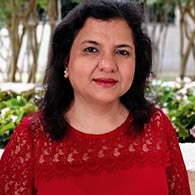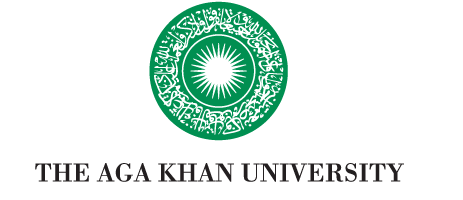Shazli Malik MBBS ’89

Dr. Shazli Malik is a graduate of the Medical College Class of 1989. Shazli is an Anatomical and Clinical Pathologist with Christus Health and Clinical Assistant Professor at the University of Texas Health Science Center.
Shazli did her Residency in Anatomic and Clinical Pathology at the North Shore University Hospital of the NYU School of Medicine, a Fellowship in Cytopathology at the University of Florida College of Medicine, and Fellowships in Surgical Pathology and Research at the University of Texas Health Science Center. She is board certified by the American Board of Pathology in Anatomic and Clinical Pathology and Cytopathology.
Shazli has made AKU the beneficiary of both her life insurance policy and her retirement plan.
Would you please tell me about your childhood?
I grew up in Karachi, where I attended a convent school. Both of my parents’ families were entrepreneurs, and one of my mother’s sisters was an OB/GYN. She and my mother were very close, and she would come to our home almost every day after work. She influenced me greatly — and even inspired me to become a doctor.
How did you come to enroll at AKU?
There was great enthusiasm about AKU at the time of its opening. Along with its being new, it was the first private medical university in Pakistan. AKU was based on Western medical schools; much of its faculty was from the West, and it was admitting only the best and brightest students in the country, the cream of the crop.
What was your life as a medical student like?
Because the hospital and medical school building were still under construction, all of my first-year classes were at the College of Physicians and Surgeons Pakistan. Even though my class had only 52 students, it was quite diverse, with students from all over Pakistan — and even the world.
The pedagogy at AKU was fundamentally different from that at the convent school. At the school, learning consisted chiefly of memorizing information and writing essays. At AKU, however, we had exams with multiple-choice questions, and since the exams had negative markings, you couldn’t guess at the answers! AKU also had oral exams, which were quite new to me, as were the open dialogue and free discussion between professors and students. I had never been taught by foreign teachers before: it took me a while to understand their colloquialisms and idioms! Because the professors were exceptional and the students highly intelligent, AKU was extremely competitive. Due to the small class size, we received close attention from all the faculty members: that contributed so much to our education. In spite of a hectic study schedule, though, we made time for fun on campus.
How did you spend the summer following your first year?
I joined an AKU-sponsored student trip to northern Pakistan, to Chitral. The people of the region suffered from iodine deficiency, presenting with goiters of various sizes, and many young children suffered from cretinism. This experience was very eye-opening: I had never seen such remarkable neck deformities before. We traveled from village to village, administering oral iodine drops to all age groups, from infants to the elderly, and were able to enjoy the local cuisine and festivities along the way. The rural village people were simple, hospitable, loving, and caring. Overall, it was a wonderful experience.
And on your return to AKU…?
By the beginning of my second year, the Community Health Sciences curriculum included outreach to low-income, underserved communities such as Grax and Chanesergoth. A group of students traveled twice a week to these settlements, conducting clinics and examining and treating patients under the supervision of a clinical preceptor. This was an incredible learning experience. In contrast to the more affluent segments of the population, which experienced ailments like those of the Western world, communicable diseases were far more prevalent in this population. The patients so appreciated our work — and we so appreciated being able to help them.
The curricula of American medical schools have either a small or no Community Health Sciences component; at AKU, that component is fully 20 percent of the curriculum. What was the catalyst for CHS?
I think it was His Highness’s vision. Aga Khan Health Services had had clinics, maternity homes, and elderly care facilities in Pakistan since the early 1950s: His Highness saw how greatly AKHS improved the quality of life for people and thus wanted to make it part of the medical school curriculum. As a result of this training, AKU alumni understand the needs of underserved communities, and many have gone on to pursue careers in public health and community medicine.
What did you specialize in?
My internship was in OB/GYN and internal medicine. While I liked both — particularly OB/GYN — I was also drawn to pathology, especially anatomic pathology, and decided to go into that field. The most exciting and challenging part of my job is intraoperative consultations, in which the surgeon waits for my diagnosis on a quick-frozen section while the surgery is still in progress. That diagnosis determines what the surgeon will do next.
Anatomic pathology — and particularly cancer pathology — is a very interesting field. Cancers can present themselves in unusual ways; diagnoses are often not straightforward or self-evident, which is what makes my work so stimulating. I don’t have direct patient contact: my clients are physicians and surgeons who depend on my tissue diagnoses to treat their patients.
May I ask about your non-professional interests?
I enjoy cooking, outdoor activities, and traveling. I participate in San Antonio events and have supported local charities such as The Children’s Shelter of San Antonio, The Battered Women’s Shelter, San Antonio Youth Literacy, Women’s Global Connection, Child Advocates San Antonio, and the Arc of Texas.
Why did you make AKF/AKU the beneficiary of your life insurance policy and your retirement plan?
Studying at the Medical College was an exceptional experience. My AKU education helped me grow into the physician I am today. Even though I had never been to the West, when I arrived in the U.S. I felt perfectly prepared, perfectly comfortable. I didn’t even have to study for the entry exams here! I was as competent as the students who had attended American medical schools — and certainly had an edge over those who had attended the other medical schools in Pakistan. Over time, I came to see that I had studied at a great institution.
I feel that I should give back to AKU for all it has done for me. Just as at a university in the West, the tuition paid by a student at AKU falls far short of the institution’s expenditure on that student. People who came before me made my education possible; it is now time for me to make the educations of others possible.
I have done well in my career: quite simply, I owe my success to AKU. I think all AKU alumni could say the same thing — and so should consider making gifts to AKU. Alumni are an integral part of an institution. In the U.S., alumni make gifts to their alma mater: they understand that the quality of the institution hinges on, depends on, that support.
I have made many gifts to AKU over the years and will continue to do so. I think it important, however, that I supplement my lifetime gifts with a gift from my estate following my passing. I chose to do this with a life insurance policy because the proceeds of the policy are so much higher than the premiums I paid: I am able to make a very large gift for a relatively small amount. What’s more, by making the Aga Khan Foundation USA the owner and beneficiary of the policy, I received a charitable deduction for each of the premium payments I made!
I also made AKF/AKU the beneficiary of my retirement plan. I did so for three reasons: 1, this is a gift that “costs me nothing now,” purely a gift in the future; 2, doing so was quite easy, only 15 minutes or so on my plan administrator’s website; and, 3, retirement plans left to children are heavily taxed: my daughters would receive less than half the amount in my plan at my passing. (Because AKU is a nonprofit entity, not a penny will be lost to taxes.)
You directed that your future gift create an endowed fund. Why did you do so?
I had always thought that when AKU received my gift, the University would use it right away, for a single project. Once I learned about endowed funds, I knew that was what I wanted to do. An endowed fund exists forever; it grows over time; I can name the fund after myself, my family, or someone I would like to honor; and, I can stipulate what cause the fund will support each year. At the moment, I am leaning toward scholarships and research — but I know that I can change that designation at any time in the future.
A Note on Endowed Funds
An endowed fund is invested in AKU’s general endowment, which is the investment portfolio of the University. The endowment — and so each of the endowed funds within it — pays out approximately five percent of its value each year, supporting everything the University does — teaching, research, financial aid, and on and on. Quite simply, the payout from the endowment is the lifeblood of AKU: the University could not function without it. The endowment — and the endowed funds within it — will exist as long as AKU exists.
An endowed fund, then, is like a “miniature endowment:” it, too, exists forever, and it, too, pays out five percent or so of its value each year. A donor can name an endowed fund after himself or herself, a family member, or anyone else he or she might wish to honour and memorialise. What is more, an endowed fund grows over time, with the endowment as a whole, thus increasing the good it does.

